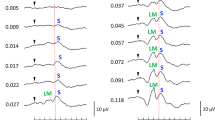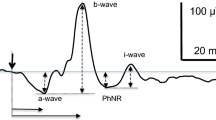Abstract
Purpose: Standard ERG a-waves represent contributions from both photoreceptor and inner retinal cells, while the leading edge of the high-intensity a-wave is produced only by photoreceptors. This has raised questions about the value of the a-wave as an indicator of photoreceptor disease, and has led to suggestions for standardizing higher-intensity stimuli. Our objective was to compare the behavior of standard and high-intensity a-waves in clinical practice. Methods: Standard ISCEV (International Society for Clinical Electrophysiology of Vision) a-waves and high-intensity a-wave responses were recorded under scotopic and photopic conditions from normal subjects and from patients with photoreceptor dystrophies and other diseases. Results: The standard scotopic a-wave amplitude followed the high-intensity a-wave closely among patients with different diagnoses, and the results did not change significantly when cone a-waves were subtracted to isolate rod signals. The only exception was one patient with the enhanced S cone syndrome (ESCS) whose dark-adapted responses were cone-driven. Initial peak times clustered in a small range for both standard and high-intensity responses, and were not very sensitive to disease. Conclusion: High-intensity a-waves can show photoreceptor characteristics directly, and may help analyze some rare disorders. However, in our study the amplitude of conventional scotopic a-waves mirrored that of the high-intensity responses quite closely over a wide range of patients. This suggests that for practical purposes even if it is not perfect, the standard ERG is an excellent indicator of photoreceptor disease.
Similar content being viewed by others
References
Marmor MF, Holder GE, Seeliger M and Yamamoto S (for the International Society for Clinical Electrophysiology of Vision). Standard for clinical electroretinography (2004 update). Doc Ophthalmol 2004; 108: 107–114
Hood DC and Birch DG (1993). Light adaptation of human rod receptors: the leading edge of the human a-wave and models of rod receptor activity. Vis Res 33: 1605–18
Hood DC and Birch DG (1993). Human cone receptor activity: the leading edge of the a-wave and models of receptor activity. Vis Neurosci 10: 857–71
Bush RA and Sieving P (1994). A proximal retinal component in the primate photopic ERG a-wave. Invest Ophthalmol Vis Sci 35: 635–44
Cideciyan AV and Jacobson SG (1996). An alternative phototransduction model for human rod and cone ERG a-waves: normal parameters and variation with age. Vis Res 36: 2609–21
Jamison JA, Bush RA, Lei B and Sieving PA (2001). Characterization of the rod photoresponse isolated from the dark-adapted primate ERG. Vis Neurosci 18: 445–55
Hood DC and Birch DG (1996). Assessing abnormal rod photoreceptor activity with the a-wave of the electroretinogram: applications and methods. Doc Ophthalmol 92: 253–67
Birch DG, Hood DC, Locke KG, Hoffman DR and Tzekov RT (2002). Quantitative electroretinogram measures of phototransduction in cone and rod photoreceptors: normal aging, progression with disease, and test–retest variability. Arch Ophthalmol 120: 1045–51
Marmor MF, Serrato A and Tzekov R (2003). Comparison of conventional ERG parameters and high-intensity a-wave analysis in a clinical setting. Doc Ophthalmol 106: 281–7
Marmor MF, Jacobson SG, Foerster MH, Kellner U and Weleber RG (1990). Diagnostic clinical findings of a new syndrome with night blindness, maculopathy and enhanced S cone sensitivity. Am J Ophthalmol 110: 124–34
Gouras P, Eggers M and Mackay C (1983). Cone dystrophy, nyctalopia and supernormal rod responses. Arch Ophthalmol 101: 718–24
Hood DC, Cideciyan AV, Halevy DA and Jacobson SG (1996). Sites of disease action in a retinal dystrophy with supernormal and delayed rod electroretinogram b-waves. Vis Res 36: 889–901
Author information
Authors and Affiliations
Corresponding author
Rights and permissions
About this article
Cite this article
Marcus, M., Cabael, L. & Marmor, M.F. Utility in clinical practice of standard vs. high-intensity ERG a-waves. Doc Ophthalmol 113, 145–153 (2006). https://doi.org/10.1007/s10633-005-5888-5
Published:
Issue Date:
DOI: https://doi.org/10.1007/s10633-005-5888-5




